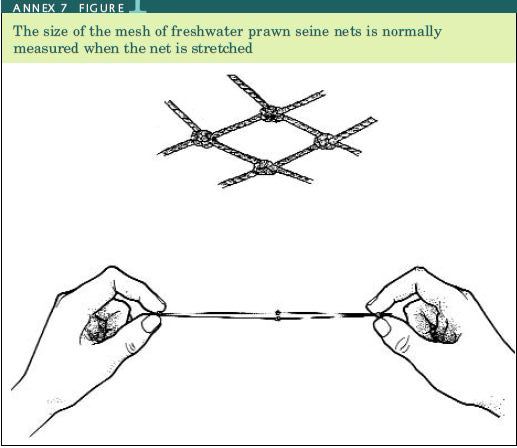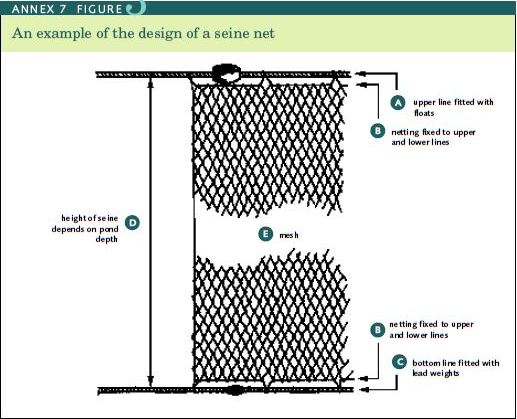7 Seine nets
THERE ARE VERY MANY different types of harvesting and sampling devices used in aqua culture, including seines, gill nets, lift nets, cast nets, bag nets, traps, and barriers. The making and use of these nets and traps is described in detail in another FAO manual (FAO, 1998). The following annex deals specifically with the use of seine nets in the cull-harvest ing of freshwater prawns; information from the original FAO freshwater prawn manual has been supplemented with material drawn from FAO (1998) and Valenti and New (2000).
3/8 inch (9.5 mm) polypropylene (common trade names: danaflex, nufil, ulstron) is suitable for the floater line (sometimes called the head line) and 1/2 inch (12.7 mm) polyamide (common trade names: nylon, perlon, amilan, anzalon) for the sinker (some times called the foot line). Nylon is soft and follows the contours of the pond, while polypropylene is light and floats, yet is stiff enough to minimize sagging. Sinker lines smaller than 1/2 inch tend to sink into the mud. Soak the ropes for 12 hours and wet stretch and dry them to prevent twisting. Both floater and sinker lines must be 2-3 m longer than the seine itself. You will also need pulling ropes. Long seines can be handled better if each end of the floater and sinker lines is fixed to a wooden pole and the pulling rope is attached to the top and the bottom of the pole. These poles can be used to stake (moor) the seine by ramming them into the bottom of the pond.
Monofilament netting is best. Double knotted, 17 1b test netting should be used. Mesh sizes (stretched) may vary from 18-50 mm; the choice depends on the market size of prawns you wish to capture. The rostrums, claws and other appendages of prawns tend to get caught in the net, so a larger mesh size than you would use for the same size (weight) of finfish can be used for freshwater prawns. For example, a stretched mesh (Annex 7, Figure 1) size of about 40 mm will retain prawns of 45 g and above.
For comparison, FAO (1998) states that a net with a stretched mesh size of this size (40 mm) retains silver carp of about 30 g, or common carp or tilapia of about 20 g. The depth of the net should be about 1.5-2.0 times the depth of the deepest water to be seined. Its length should also be at least 1.5 times the width of the pond through which it will be drawn. Monofilament of 60 lb test should be used to fix the netting to the floater and sinker lines, using a ‘double clove hitch’ at every third eye. Net ends should be reinforced with a heavy strand of nylon to prevent tearing. A seine net being used for harvesting prawns is illustrated in Annex 7, Figure 2 and a typical design for a seine net is shown in Annex 7, Figure 3.
Sufficient floats should be used to prevent the line sagging. If this occurs, some prawns will crawl over the net. In general, a float can support a weight (its ‘floatability’) equivalent to 80-90% of its volume; a single 70 mm x 40 mm egg-shaped or oval-shaped float with a hole diameter of 9 mm can support a weight of 63 g. Cylindrical plastic (PVC or polyurethane) floats, 64 mm long and 64 mm in diameter have been used on freshwater prawn seines, for example. Moulded U-shaped leads are favoured against commercial
ANNEX 7 FIGURE1
The size of the mesh of freshwater prawn seine nets is normally measured when the net is stretched

SOURCE: EMANUELA D’ANTONI
sinkers as they have a smaller cross-section. The total weight of the lead sinkers needs to be 1-1.5 times the total floatability of the floats. Leads cut to 37 mm from a 3 mm thick sheet, weighing about 60 g, hammered onto the sinkers every 28 cm are suggested for freshwater prawn seines.
Some seines used for freshwater prawns have a bag similar to that of a beach seine, except that the top is
left open and the dis tance between the floaters is reduced to prevent prawns from escaping over the top. A bag with floor dimen sions of 15 ft x 9 ft (approximately 4.6 m x 2.7 m), tapering down to 4 ft (~1.2 m), will hold 200 kg of
live prawns. Many
ANNEX 7, Figure 2
Freshwater prawns (Macrobrachium rosenbergii) can be cull-harvested by seining (Hawaii)

SOURCE: TAKUJI FUJIMURA
seines used for harvesting freshwater prawn grow-out ponds have no bag, but a temporary catch area is made by the seine operators drawing in the sinker line as the seine is pulled towards the bank. Where prawns are to be transferred to another pond, for example from a nursery pond to a grow-out pond, the use of a bagged seine net may lessen the amount of damage to the prawns.
ANNEX 7 FIGURE3
An example of the design of a seine net

SOURCE: EMANUELA D’ANTONI